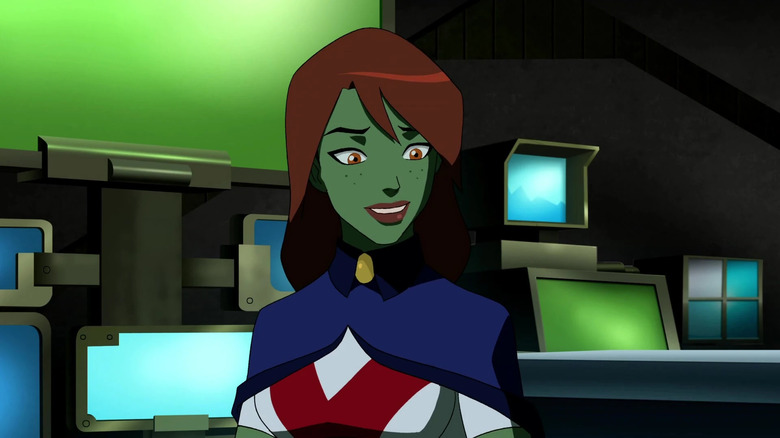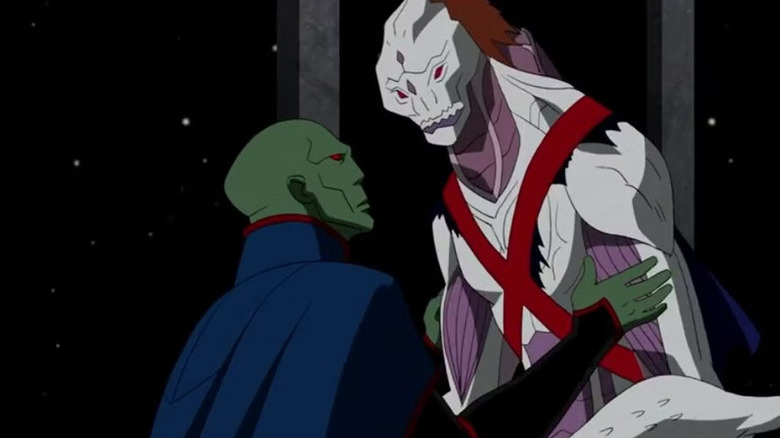Why Mars Wasn't Destroyed In Young Justice's Version Of The DC Universe
Arguably, the most famous fictional planet is Krypton — the home of Kal-El, aka Clark Kent, aka Superman. We all know the story (though studios seem to think we don't) of how Krypton was destroyed, and how the sole (kind of) survivor was baby Kal-El. But while Krypton gets all the attention, it's not the only desolated former metropolis in the DC Universe.
Another essential part of the DC mythos is Mars, our red neighbor. In most of the DC continuity, Mars is mostly devoid of life, with all civilizations having been wiped out through war or a plague, leaving only J'onn J'onzz, aka the Martian Manhunter, alive and stranded on Earth. That is not the case with the acclaimed "Young Justice" animated series, which portrays Mars as having a big, advanced, and very active Martian civilization.
This was by design. The show, which is one of the best superhero TV shows out there, pulls from all corners of the DC Universe while crafting its own continuity. The result feels like a lived-in, standalone fictional universe that is ever-expanding and maturing, where actions have consequences, time passes, and heroes die or retire.
"While developing the first season, we decided that Krypton should be unique in its destruction," co-creator Greg Weisman told DC. "Having every alien come from a dead world brought us nothing new. But having M'arzz be a living, thriving — if troubled — society was bound to bring us stories."
Indeed, as co-creator Brandon Vietti added, having a thriving Martian society added dramatic weight to the character of M'gann, aka Miss Martian. "We needed that weight to craft a truly unique coming-of-age story for her."
The problem with Mars
Granted, the very first origin story for Martian Manhunter didn't include Mars being a dead world. Instead, he was simply stranded on Earth following an experiment gone wrong. However, after the big "Crisis on Infinite Earths" reset button, Mars was obliterated — probably in an effort to make Manhunter more like Superman.
Having Mars be a thriving society is one of the wiser things "Young Justice" does. It not only makes Superman's story unique, as Weisman said, but it also gives the show an avenue to explore mature subjects involcing social issues in a way that kids can easily understand (while tricking the parents who, for some reason, refuse to let their kids learn about the world they live in).
You see, in the first season of "Young Justice," we meet Miss Martian, the niece of Martian Manhunter. It is quickly revealed that Miss Martian is actually a white Martian, while Martian Manhunter and the majority of Mars' population are green Martians. Turns out that, despite there being no genetic differences between them, there are several races on Mars, and white Martians have historically been severely oppressed and treated as second-class citizens. Indeed, Miss Martian suffered so much bullying that it led to her leaving her home behind and seeking a new life on Earth.
"Young Justice: Phantoms" went deeper with this, as Miss Martian, Superboy, and Beast Boy travel to Mars to make preparations for the former pair's wedding, only to get involved in a conflict between white and green Martians after the assassination of the king.
After four seasons, Mars ended up being a rare non-Earth location that "Young Justice" developed and turned into a place that felt lived-in. To think, we could have lost that to just another Krypton-like cataclysm.

